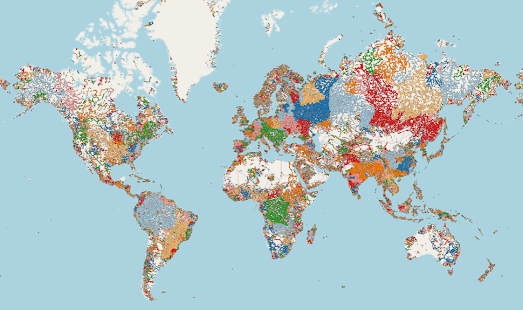The River Basins & Watersheds of the World
OSM River Basins is an interactive map which uses OpenStreetMap data to visualize all the river basins of the world.
Like all maps OSM River Basins may contain errors or incomplete data. However, because the map uses OpenStreetMap data any errors can be easily rectified by correcting the data on OSM. You might also be able to find a more accurate visualization of your local river basin(s) by playing with the map options (e.g. by selecting the 'waterway=river or canal' radio button).
You can explore watersheds on the Global Watersheds interactive map. Click anywhere on the Global Watersheds map and you can view a visualization of the upstream watersheds calculated from your selected location. The map allows you to quickly see where water is coming from and where it is going at any location on Earth.
You can view an animated journey of the downstream flow path of a river on the River Runner interactive map. River Runner Global allows you to virtually drop a raindrop anywhere in the world to visualize its journey to the sea. You can select any location in the world on the map and then watch the animated journey that a raindrop would take from that location downstream to the sea.
A river basin is an area of land drained by one river system and its tributaries. It includes all the land where rainwater or melted snow drains into the river, either directly or through smaller tributary streams and rivers. River basins can be incredibly large - covering thousands of square kilometers, or very small - covering just a few square kilometers.
A watershed is a smaller and more localized area within a river basin. It is a specific area of land where all the water that flows over or under it converges into a common point, such as a lake, river, or wetland. Watersheds are often delineated based on the topography or land contours, where the water collects and drains towards a particular outlet.
In simple terms, a river basin is a larger region drained by a river, while a watershed is a smaller area within that basin where all the water flowing within it converges to a common point. River basins can have multiple watersheds within them, each contributing water to different sections of the river system.
The screenshot above shows the huge 1 million km² watershed flowing from the Andes into the Solimões River in Brazil. If you want to view the world's largest watersheds on the Global Wathershed map then click downstream in the Amazon Basin (the world's largest watershed) or downstream in the Mississippi River Watershed in the United States.
If you wish to see where a watercourse flows to then you can select the 'downstream' option on the map. This will then display the flow path of the selected river from the selected location to the ocean. Other options allow you to download the data of a watershed in geoJSON, shapefile or KML formats.




Comments